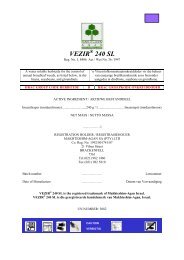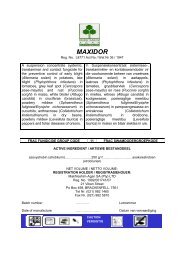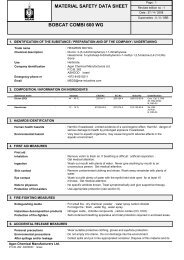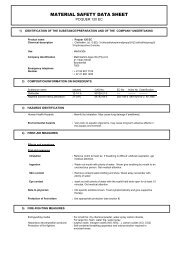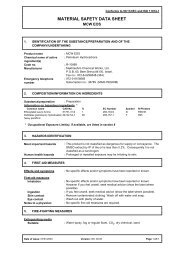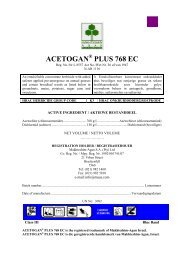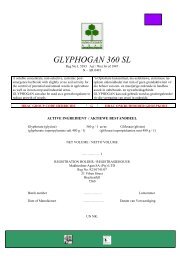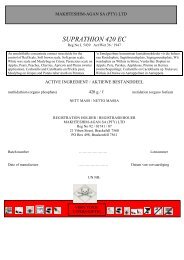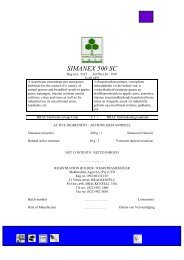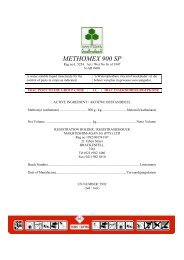You also want an ePaper? Increase the reach of your titles
YUMPU automatically turns print PDFs into web optimized ePapers that Google loves.
A suspension concentrate: root and foliar absorbed<br />
herbicide for the control of the weeds mentioned in the<br />
crops listed.<br />
<strong>MAKHTESHIM</strong>-<strong>AGAN</strong> <strong>SA</strong> (<strong>PTY</strong>) <strong>LTD</strong><br />
<strong>LIN<strong>AGAN</strong>®</strong> <strong>SC</strong><br />
Reg No L 6294 Act / Wet 36 of 1947<br />
N – AR 0492<br />
‘n Suspensiekonsentraat: wortel- en blaaropneembare<br />
onkruiddoder vir die beheer van die onkruide vermeld in<br />
die genoemde gewasse.<br />
HERBICIDE GROUP CODE C 2 ONKRUIDDODER GROEPKODE C 2<br />
ACTIVE INGREDIENT / AKTIEWE BESTANDDEEL<br />
Linuron (Urea) 500 g / l Linuron (Ureum)<br />
NET VOLUME / NETTO VOLUME<br />
…………… l<br />
REGISTRATION HOLDER / REGISTRASIEHOUER<br />
Makhteshim-Agan <strong>SA</strong> (Pty) <strong>LTD</strong><br />
Reg No. 92/01741/07<br />
21 Viben Street<br />
Brackenfell<br />
7560<br />
Batch number ……………. Lotnommer<br />
Date of Manufacture ………………. Datum van Vervaardiging<br />
AFALON <strong>SC</strong> is the registered trademark of Makhteshim-Agan Israel.<br />
AFALON <strong>SC</strong> is die geregistreerde handelsmerk van Makhteshim-Agan, Israel.<br />
UN NR:<br />
(blue/blou)<br />
CAUTION<br />
VERSIGTIG
WARNINGS<br />
• Do not graze treated areas<br />
• Poisonous by swallowing. May irritate eyes, nose, throat and skin.<br />
• Poisonous to fish.<br />
• Store in a cool place away from fertilizers, food and feeds.<br />
• Keep out of reach of children, uninformed persons and animals<br />
• Although LIN<strong>AGAN</strong> has been tested on most important cultivars and no significant effect have been<br />
recorded, this does not mean that a more susceptible cultivar cannot be commercialized in the future.<br />
Where new cultivars are encountered large areas should not be sprayed without prior testing of<br />
LIN<strong>AGAN</strong> on that cultivar.<br />
• Although this remedy has been extensively tested under a large variety of conditions the<br />
registration holder does not warrant that it will be efficacious under all conditions because the<br />
action and effect thereof may be affected by factors such as abnormal soil, climatic and storage<br />
conditions, quality of dilution water, compatibility with other substances not indicated on the label<br />
and the occurrence of resistance of the weeds to the remedy concerned as well as by the method,<br />
time and accuracy of application. The registration holder furthermore does not accept<br />
responsibility for damage to crops, vegetation, the environment or harm to man or animal or for<br />
lack of performance of the remedy concerned due to failure of the user to follow the label<br />
instructions or to the occurrence of conditions which could not have been foreseen in terms of the<br />
registration. Consult the supplier in the event of any uncertainty.<br />
• Aerial application: Notify all inhabitants in the immediate vicinity to be sprayed and issue the necessary<br />
warnings. Do not spray over or allow drift to contaminate water or adjacent areas.<br />
PRECAUTIONS<br />
• Do not inhale vapour of spray mist<br />
• Wear protective clothing, gloves, overall and boots when handling he concentrate and when applying the<br />
product.<br />
• Wash immediately after accidental skin contact with soap and cold water.<br />
• Do not eat, drink or smoke whilst applying, mixing or before hands and face have been washed (change<br />
of clothing)<br />
• PREVENT DRIFT ONTO OTHER EDIBLE CROPS, GRAZING, RIVERS, DAMS AND AREAS<br />
NOT UNDER TREATMENT.<br />
• Clean applicator/aircraft thoroughly before re-using with other materials. Dispose of wash water where<br />
it will not contaminate grazing, food or water.<br />
• Invert the empty container over the spray – or mixing tank for at least 30 seconds after the flow has<br />
slowed down to a drip. Thereafter rinse the empty container three times with a volume of water equal to<br />
a minimum of 10 % of that of the container and add the rinsing to the contents of the spray tank before<br />
disposing of the container in the prescribed manner.<br />
• Destroy empty container by perforation and flattening and never use for an other purpose.<br />
• Ensure that the spray does not drift over grazing, crops not under treatment or water sources<br />
• Keep animals and children away from stacked and spilt material<br />
• No worker should be engaged in handling or marking operations while suffering from any major<br />
complaint or from certain minor complaints such as bronchitis or stomach trouble.<br />
Resistance warning:<br />
For resistance management Linagan is a groupcode C 2 herbicide. Any weed population may contain<br />
individuals naturally resistant to Linagan and other group code C herbicides. The resistant individuals can<br />
eventually dominate the wed population if these herbicides are used repeatedly. These resistant weeds may not<br />
be controlled by Linagan or any other group code C herbicides.<br />
To delay herbicide resistance:
1) Avoid exclusive repeated use of herbicides of the same herbicide group code. Alternate or tank mix<br />
with products from different herbicide group codes.<br />
2) Integrate control methods (Chemical & Cultural) into weed control programmes or specific information<br />
on resistance management contact the registration holder of this product.<br />
DIRECTIONS FOR USE: USE ONLY AS DIRECTED<br />
CROP APPLICATION METHOD AND<br />
SOIL TYPE<br />
CARROTS, PARSLEY<br />
AND PARSNIPS<br />
MAIZE<br />
(under irrigation)<br />
POTATOES<br />
(under irrigation)<br />
SWEET POTATO<br />
TRANSPLANTS<br />
(CUTTINGS)<br />
GLADIOLI<br />
Pre-emergence:<br />
Loamy sand 11 – 15 % clay<br />
Sandy loam 16 – 20 % clay<br />
Sandy clay loam 21 – 35 % clay<br />
Post-emergence<br />
Dosage depends upon growth stage<br />
of the weeds<br />
Post-emergence:<br />
11 – 35 % clay<br />
21 – 35 % clay<br />
11 – 35 % clay<br />
21 – 35 % clay<br />
Pre-emergence (of crop)<br />
Loamy sand 11 – 15 % clay<br />
Sandy loam 16 – 20 % clay<br />
Sandy clay loam 21 – 35 % clay<br />
Pre-emergence (of weeds)<br />
Loamy sand 11 – 15 % clay<br />
Sandy loam 16 – 20 % clay<br />
Sandy clay loam 21 – 35 % clay<br />
Post-emergence (of weeds)<br />
ROSES Pre-budburst:<br />
Pre-emergence:<br />
Loamy sand 11 – 15 % clay<br />
DO<strong>SA</strong>GE / HECTARE<br />
1,0 ℓ in 300 ℓ water<br />
1,5 ℓ in 300 ℓ water<br />
2,0 ℓ in 300 ℓ water<br />
1 – 1,5 ℓ in 300 – 500 ℓ water<br />
Dosage depends upon growth stage<br />
of the weeds<br />
Overall treatment as a directed spray<br />
to weeds:<br />
1,5 ℓ in 300 ℓ water for weeds up to<br />
50 mm in height<br />
2,5 ℓ in 500 ℓ water only when<br />
weeds exceed 50 mm height but are<br />
not taller than 75 mm.<br />
50 cm Band treatment after early<br />
cultivation:<br />
8,5 ml in 3 ℓ water / 100 m row for<br />
weeds up to 50 mm in height<br />
14 ml in 5 ℓ water / 100 m row only<br />
when weeds exceeds 50 mm but are<br />
not taller than 75 mm.<br />
ADD A WETTER<br />
2,0 ℓ in 300 – 500 ℓ water<br />
2,5 ℓ in 300 – 500 ℓ water<br />
3,0 ℓ in 300 – 500 ℓ water<br />
1,5 ℓ in 300 ℓ water<br />
1,75 ℓ in 300 ℓ water<br />
2,0 ℓ in 300 ℓ water<br />
1,5 – 2 ℓ in 300 – 500 ℓ water<br />
Dosage depends upon growth stage<br />
of the weeds.<br />
2,0 ℓ in 300 ℓ water
Sandy loam 16 – 20 % clay<br />
Sandy clay loam 21 – 35 % clay<br />
Post budburst:<br />
Directed post emergence<br />
CROPS REMARKS<br />
2,5 ℓ in 300 ℓ water<br />
3,0 ℓ in 300 ℓ water<br />
3 – 4 ℓ in 300 – 500 ℓ water<br />
Dosage depends upon growth stage<br />
of the weeds.<br />
CARROTS, Pre-emergence:<br />
PARSLEY AND Seed should be sown no less than 1,25 cm deep in a fine seedbed (See General)<br />
PARSNIPS<br />
IRRIGATED MAIZE OVERALL APPLICATION:<br />
Post-emergence:<br />
When spraying do not apply before the Carrots have reached the 4 leaf stage.<br />
The best time to spray is when the weeds are in the 2 – 3 leaf stage and do not<br />
exceed 50 mm in height. Use 300 ℓ spray mixture per hectare. Use 500 ℓ<br />
mixture / ha on weeds which are in the 3- 5 leaf stage, but are not taller than 75<br />
mm. Do not apply when temperature exceeds 30 °C. Do not exceed 3 bars<br />
pressure as crop injury may result. The addition of full concentration<br />
wetter/spreader can result in crop injury.<br />
RESPRAYS: Resprays are permissible for both pre-and post-emergence as<br />
long as the total dosage is not more than 2 x the prescribed dosage for the<br />
situation for which it has been recommended and should in no instance exceed<br />
4 ℓ / ha. Makhteshim-Agan <strong>SA</strong> (Pty) Ltd is not in a position to continuously<br />
test LIN<strong>AGAN</strong> on all new cultivars. If phytotoxic symptoms such as leaf<br />
tipburn should be noticed on any cultivar after a spray it would not be advisable<br />
to use this chemical for a second time on that cultivar during the same growing<br />
season.<br />
Make a single application, as a directed spray after Maize is at least 350 –<br />
500 mm high (measured to the highest leaf on freestanding plants).<br />
Do not spray over the top of Maize. Apply only when there is sufficient<br />
differential between height of Maize and weeds so that the directed spray (drop<br />
arms) thoroughly cover all weed foliage without contact of upper leaves or<br />
whorl of maize by spray or drift. Such contact may cause injury. Early<br />
cultivation (rolling tine cultivator or other suitable equipment) can aid in<br />
achieving proper differential between height of maize and weeds. Where early<br />
cultivation has taken place only a band treatment will be necessary. Weeds<br />
should be growing vigorously and not be wilted and suffering from drought<br />
stress when the spray is applied.<br />
BAND TREATMENT<br />
Apply by means of a tractor-mounted power sprayer properly calibrated to a<br />
constant speed and rate of delivery. The use of drop arms is recommended.<br />
For a 50 cm (25 + 25 cm) band: dose in 3 ℓ water per 100 m row = 8,5 ml<br />
(Weeds up to 50 mm high)<br />
dose in 5 ℓ water per 100 m row = 14 ml<br />
(Weeds up to 75 mm high)
REPLANTING<br />
Fields with soil containing in excess of 10 % clay which have been treated with<br />
ALANEX pre-emergence treatment followed by LIN<strong>AGAN</strong> may immediately<br />
be replanted to Maize, and Soybeans if initial seeding fails to produce a<br />
satisfactory stand. 30 Days should elapse after treatment before Dry or Green<br />
beans, or Sunflowers can be planted. Thoroughly rework soil before replanting.<br />
Sorghum should not be replanted into ALANEX / LIN<strong>AGAN</strong> treated soil and a<br />
waiting period of six months is recommended in this case. By thoroughly<br />
reworking the soil prior to replanting the ALANEX will be diluted to such an<br />
extent that weed control will be ineffectual. Do not re-treat fields with a second<br />
application during the same crop year.<br />
Do not plant LIN<strong>AGAN</strong> susceptible crops within 4 months of treatment.<br />
AFALON <strong>SC</strong> IN CONJUNCTION WITH ALANEX FOR PRE AND POST-<br />
EMERGENCE WEED CONTROL IN IRRIGATED MAIZE.<br />
Read the ALANEX labels before use and apply according to the manufacture’s<br />
recommendations. LIN<strong>AGAN</strong> weed killer following a pre-emergence spray of<br />
ALANEX herbicide for grass control is recommended for use as a postemergence<br />
spray in maize for the selective control of seedling annual broadleaf<br />
weeds.<br />
HOW TO USE:<br />
Make a single application of ALANEX as a broadcast or band spray after<br />
planting but before maize emerges. Follow up with a post emergence treatment<br />
of LIN<strong>AGAN</strong> as described above.<br />
WINTER FOLLOW UP CROPS:<br />
When ALANEX / LIN<strong>AGAN</strong> is used in the fashion described above no<br />
difficulties can be expected with winter follow up crops planted outside the 4month<br />
safety period (See point 7 of “General”).<br />
IRRIGATED POTATOES May be sprayed after planting until prior to emergence of first leaves of crop.<br />
Seed should be planted at least 5 cm deep and seedbed should be free of clods.<br />
Where no weed growth is yet present, or when weeds are in the 2 – 3 leaf stage,<br />
and do not exceed 50 mm in height and the potatoes have not yet emerged, use<br />
300 ℓ mixture / ha. Where potatoes have not yet emerged, but weeds are in the<br />
2 – 5 leaf stage but not taller than 75 mm, use 500 ℓ mixture / ha. Grasses<br />
should not be allowed to exceed 50 mm in height. Where a band treatment is<br />
used proportionally fewer chemicals than for the overall treatment must be used.<br />
If weeds have already germinated, it is advisable to ADD A WETTER.<br />
SWEET POTATOES Apply immediately after transplanting before active growth starts. Give light<br />
sprinkle irrigation after application to wash herbicide off the leaves of the<br />
cuttings. Alternatively, spray first and transplant directly thereafter, ensuring<br />
that soil is not unduly disturbed, and that the minimum amount of trampling<br />
takes place. The first option is the better one.<br />
GLADIOLI Do not spray later than 2 days before crop emergence. Use 300 ℓ
mixture / ha on weeds in the 2 – 3 leaf stage which do not exceed 50 mm in<br />
height and 500 ℓ mixture on weeds in the 2 – 5 leaf stage which are not taller<br />
than 75 mm. Use lower dose in 300 ℓ water and higher dose in 500 ℓ water / ha.<br />
ROSES Pre-bud burst:<br />
Apply in spring before Roses commence bud-burst. Use 20 – 30 ml in 3 ℓ<br />
water / 100 m². (i.e 2 – 3 ℓ / ha dependant on soil type). 1 ha = 10 000 m².<br />
Post-bud burst, Post-emergence:<br />
For directed post emergence sprays ensure that growing roses are well shielded.<br />
Use 3 ℓ in 300 ℓ water / ha for weeds in 2 – 5 leaf stages which do not exceed<br />
50 mm in height and 4 ℓ in 500 ℓ water / ha for weeds in the 5 – 7 leaf stage<br />
which do not exceed 75 mm in height.<br />
EQUIPMENT For field crops: Use a tractor-mounted fixed-boom power sprayer properly<br />
calibrated to a constant speed and rate of delivery. Openings in filters should be<br />
equal to or larger than 50 mesh. Continuous agitation in the spray tank is<br />
required to keep the material in suspension. Agitate by mechanical or hydraulic<br />
means. If a by-pass or return line is used, it should terminate at the bottom of<br />
the tank to minimize foaming. Do not use air agitation. Avoid over-lapping<br />
and shut off booms while starting, turning, slowing or stopping, or injury to the<br />
crop may result. 8004 flat fan nozzles for both pre-and post-emergence sprays<br />
on crops other than maize are recommended and a spray pressure of 2,5 – 3<br />
bars in the case of the former, while using 1,5 - 2 bars in the case of the latter<br />
application method. For post-emergence weed control in maize a 6504 flat fan<br />
nozzle operating at 1,5 – 2 bars to spray a 250 mm band on each side of the row<br />
is recommended.<br />
For Horticultural crops: A knapsack sprayer operated at constant speed using<br />
the same nozzle as described above is suitable.<br />
GENERAL Do not use LIN<strong>AGAN</strong> on calcitic or newly limed soils<br />
Pre-emergence sprays:<br />
1. Sprays should be applied either to a moist soil surface or a light<br />
irrigation to activate the herbicide should follow shortly after<br />
application.<br />
2. A good seedbed must be prepared before application of<br />
LIN<strong>AGAN</strong>. Crop injury may result if application is made to<br />
ground, which is cloddy, or compacted resulting in improperly<br />
planted seed. Plant seed at depth specified.<br />
3. Surface of the soil should not be cultivated or disturbed after<br />
application of LIN<strong>AGAN</strong> and before emergence of the crop as<br />
weed control may be reduced and crop injury may be possible. If<br />
soil moisture is insufficient to activate the herbicide, a shallow<br />
cultivation should be made after emergence of row crops while<br />
weeds are small enough to be controlled by mechanical means.<br />
4. Do not use LIN<strong>AGAN</strong> pre-emergence where water logging may<br />
occur.<br />
5. Do not use LIN<strong>AGAN</strong> pre-emergence on gravelly soils or exposed<br />
subsoil.<br />
6. Certain weeds which are able to germinate form lower soil depths,<br />
such as Datura, (Thorn apple) and Cosmos are not always<br />
effectively controlled by pre-emergence applications.
7. It is recommended that soil treated with LIN<strong>AGAN</strong> should not be<br />
sown or planted with LIN<strong>AGAN</strong> sensitive crops within 4 months of<br />
initial treatment. Lettuce is particularly sensitive and problems may<br />
be encountered if it is sown during the same season that the initial<br />
treatment with LIN<strong>AGAN</strong> took place.<br />
8. The pre-emergence control of deep and/or late germinating weeds<br />
may sometimes be erratic.<br />
Post-emergence sprays:<br />
Optimum results are obtained with post-emergence application<br />
under conditions of high humidity and temperatures of 16 – 25 °C<br />
when weeds are growing vigorously.<br />
Aerial application of LIN<strong>AGAN</strong> may only be done by a registered Aerial Application Operator using a correctly<br />
calibrated, registered aircraft according to the instructions of <strong>SA</strong>BS Code 0118 (Aerial Application of<br />
Agricultural Pesticides). Ensure that the spray mixture is distributed evenly over the target area and that the loss<br />
of spray material during application is restricted to a minimum. It is therefore essential that the following criteria<br />
be met:<br />
• Volume: A spray mixture volume of 30 litres per hectare is recommended. As this product has not been<br />
evaluated at a reduced volume rate, the registration holder cannot guarantee efficacy, or be held responsible<br />
for any adverse effects if this product is applied aerially at a lower volume rate than recommended above.<br />
• Droplet coverage: 20 to 30 droplets per cm² must be recovered at the target area.<br />
• Droplet size: A droplet spectrum with a VMD of 350 to 400 microns is recommended. Limit the production<br />
of fine droplets less than 150 microns (high drift and evaporation potential) to a minimum.<br />
• Flying height: Maintain the height of the spray boom at 3 to 4 metres above the target. Do not spray when<br />
aircraft dives, is in a climb or when banking<br />
• Use suitable atomising equipment that will produce the desired droplet size and coverage, but which will<br />
ensure the minimum loss of product. The spraying system must produce a droplet spectrum with the lowest<br />
possible Relative Span.<br />
• Position all the atomisers within the inner 60 to 75 % of the wingspan to prevent droplets from entering the<br />
wingtip vortices.<br />
• The difference in temperature between the wet and dry bulb thermometers, of a whirling hygrometer, should<br />
not exceed 8°C.<br />
• Stop spraying if the wind speed exceeds 15 km/h.<br />
• Stop spraying under turbulent, unstable and dry conditions during the heat of the day.<br />
• Spraying under temperature inversion conditions (spraying in or above the inversion layer) and/or high<br />
humidity conditions (relative humidity 80 % and above) may lead to the following:<br />
a) reduced efficacy due to suspension and evaporation of small droplets in the air (inadequate coverage).<br />
b) damage to other sensitive crops and/or non-target areas through drifting of the suspended spray cloud<br />
away from the target field.<br />
• Ensure that the Aerial Spray Operator knows exactly which fields to spray.<br />
• Obtain an assurance from the Aerial Spray Operator that the above requirements will be met and that<br />
relevant data will be compiled in a logbook and kept for future reference.
WEEDS CONTROLLED BY LIN<strong>AGAN</strong>:<br />
BROADLEAF WEEDS:<br />
Acanthospermum hispidum Upright starbur<br />
Amaranthus deflexus Perennial pigweed<br />
A. spinosus Thorny pigweed<br />
A. hybridus Common pigweed<br />
Amsinckia calycina Fiddleneck<br />
Artotheca calendula Cape marigold<br />
Bidens bipinnata Spanish blackjack<br />
Bidens pilosa Common blackjack<br />
Bilderdykia convolvulus Wild buckwheat<br />
Capsella bursa-pastoris Shepherds purse<br />
Cenia turbinata Mayweed<br />
Chenopodium album White goosefoot<br />
Cosmos bipinnatus Cosmos<br />
Datura spp. Thorn apple<br />
Emex australis Spiny emex<br />
Euphorbia hirta Red euphorbia<br />
Galinsoga parviflora Small flowered quickweed<br />
Lactuca serriola Wild lettuce<br />
Lepidium africanum Pepperweed<br />
Physalis angulata Wild gooseberry<br />
Polygonum aviculare Prostrate knotweed<br />
Portulaca oleracea Common purslane<br />
Raphanus raphanistrum Wild radish<br />
Schuhria pinnata Dwarf marigold<br />
Scleranthus annuus Annual scleranthus<br />
Sisymbrium thellungii Wild mustard<br />
Sonchus oleraceus Common sowthistle<br />
Spergula arvensis Corn spurry<br />
Stellaria media Chickweed<br />
Tagetes minuta Tall khakiweed<br />
Veronica persica Ironweed<br />
Vicia sativa Common vetch<br />
GRASSES:<br />
Chloris pycnothrix Spiderweb chloris<br />
Echinochloa crusgalli Barnyard grass<br />
Eleusine indica Goosegrass<br />
* Lolium multiflorum Italian ryegrass<br />
* Lolium temulentum Darnel<br />
Panicum schinzii Vlei panicum<br />
Phalaris canariensis Canaryseed grass<br />
Poa annua Annual bluegrass<br />
Setaria pallide – fusca Garden bristle grass<br />
Tragus berteronianus Spike carrotseed grass<br />
Tragus racemosus Carrotseed grass
NOTE:<br />
Post-emergence – Cyperus esculentus – Yellow nutsedge control in carrots is variable but can be enhanced by<br />
allowing an acceptable leaf area to develop and then adding a wetter at 50 % the recommended concentration.<br />
Slight scorching of the carrot leaves may occur but this disappears with time.<br />
Digitaria sanguinalis – Crab fingergrass, is only controlled by LIN<strong>AGAN</strong> under very favourable conditions<br />
• Variable results are sometimes obtained on Lolium spp. – Ryegrass and Darnel.<br />
Medicago polymorpha – Burrclover, is not controlled by LIN<strong>AGAN</strong>.<br />
ALANEX (Reg No L 4752 Act 36 / 1947) contains alachlor, is the registered trade mark of<br />
Makhteshim-Agan <strong>LTD</strong>, Israel
WAARSKUWINGS<br />
• Moet nie behandelde gebiede laat bewei nie<br />
• Giftig indien ingesluk<br />
• Mag oë, neus, keel en vel irriteer<br />
• Giftig vir vis.<br />
• Hou buite bereik van kinders, oningeligte persone en diere<br />
• Bewaar in koel plek weg van kunsmisstowwe, voedsel en voer<br />
• Alhoewel LIN<strong>AGAN</strong> op die mees belangrike kultivars getoets is, met geen betekenisvolle<br />
fititoksiese simptome nie, beteken dit nie dat ‘n meer vatbare kultivar dalk in die toekoms<br />
gekommersialiseer kan word nie. Waar nuwe kultivars teëgekom word, moet groot areas nie<br />
behandel word voordat u LIN<strong>AGAN</strong> op daardie kultivar getoets het nie.<br />
• Alhoewel hierdie middel omvattend onder ‘n groot verskeidenheid toestande getoets is<br />
waarborg die registrasiehouer nie dat dit onder alle toestande doeltreffend sal wees nie<br />
aangesien die werking en effek daarvan beinvloed kan word deur faktore soos abnormale<br />
grond, klimaats- en bergingstoestande, kwaliteit van die verdunningswater, verenigbaarheid<br />
met ander stowwe wat nie op die etiket aangedui is nie en die voorkoms van weerstand van<br />
die onkruide teen die betrokke middel sowel as die metode, tyd en akkuraatheid van<br />
toediening. Verder aanvaar die registrasiehouer nie verantwoordelikheid vir skade aan<br />
gewasse, plantegroei, die omgewing of vir nadelige effek op mens of dier of vir ‘n gebrek aan<br />
prestasie as gevolg van die versuim van die gebruiker om etiketaanwysings na te kom of as<br />
gevolg van die ontstaan van toestande wat nie kragtens die registrasie voorsien kon word<br />
nie. Raadpleeg die verskaffer in die geval van enige onsekerheid.<br />
• Lugtoediening: Stel alle inwoners in die onmiddellike omgewing van die gebied wat gespuit sal<br />
word in kennis en reik die nodige waarskuwings uit. Moet nie oor water of aangrensende gebiede<br />
spuit of die spuitstof daarheen laat wegdryf nie.<br />
VOORSORGMAATREëLS<br />
• Vermy inaseming van dampe en spuitnewel<br />
• Dra beskermende klere, handskoene, oorpak en stewels wanneer konsentraat hanteer word en<br />
wanneer produk toegedien word.<br />
• Was onmiddellik met seep en koue water na toevallige kontak met die liggaam<br />
• Moet nie eet, drink of rook gedurende aanwending, vermenging of voor hande en gesig gewas is<br />
nie (wissel van klere)<br />
• VERMY DIE OORWAAI NA ANDER EETBARE GEWASSE, WEIDING, RIVEIRE, DAMME<br />
EN GEBIEDE WAT NIE ONDER BEHANDELING IS NIE.<br />
• Maak die spuittoestel / vliegtuig deeglik skoon voor dit weer gebruik word vir die toediening van<br />
‘n ander middel. Spoel daarna die leë houer driekeer met ‘n volume water gelyk aan ‘n minimum<br />
van 10 % van die houer en voeg spoelwater by die inhoud van die spuittenk voor houer op die<br />
voorgeskrewe wyse vernietig word.<br />
• Keer die leë houer om oor die spuittenk of mengbak en dreineer vir minstens 30 sekondes nadat<br />
die vloei tot ‘n gedrup verminder het.<br />
• Vernietig leë houer deur dit te deurboor en plat te slaan en moet nie weer vir enige ander doel<br />
gebruik nie<br />
• Gooi waswater uit waar dit nie voedsel, weiding of water sal besoedel nie.<br />
• Sorg dat die spuitnewel nie ander gewasse of waterbronne besoedel nie.<br />
• Hou kinders en diere weg van opgestapelde en vermorste materiaal<br />
• Geen werker mag deelneem aan die hantering, of merkproses terwyl hy aan enige groot kwaal ly of<br />
selfs sommige kleiner klagtes soos brongitis of maagaandoening het nie.
Bestandheidswaarskuwing:<br />
Linagan is ‘n groepkode C 2 onkruiddoder. Enige populasie van ‘n spesifieke onkruid mag individue<br />
insluit wat ‘n natuurlike weerstand teen Linagan of enige ander groepkode C onkruiddoders het. Indien<br />
hierdie onkruiddoders herhaaldelik aangewend word, kan die weerstandbiedende individue uiteindelik die<br />
onkruidpopulasie oorheers. Hierdie weerstandbiedende onkruide sal waarskynlik nie deur Linagan of<br />
enige ander groepkode C onkruiddoder beheer word nie.<br />
Om weerstand teen onkruiddoders te vertraag:<br />
1) Vermy die eksklusiewe herhaaldelike grebruik van onkruiddoers met dieselfde groepkode .<br />
Wissel af met of gebruik tenkmengsels van produkte in verskillende onkruiddoder groepkodes.<br />
2) Integreer ander beheermaatreëls (Chemies + Verbouing) in onkruiddoder programme.<br />
Vir spesifieke inligting oor weerstandsbestuur kontak die registrasiehouer van hierdie produk.<br />
GEBRUIK<strong>SA</strong>ANWYSINGS: GEBRUIK SLEGS SOOS AANGEDUI<br />
GEWAS TOEDIENINGSMETODE EN<br />
GRONDSOORT<br />
WORTELS,<br />
PIETERSIELIE EN<br />
WITWORTELS<br />
MIELIES<br />
(onder besproeiing)<br />
AARTAPPELS<br />
(onder besproeiing)<br />
Vooropkom:<br />
Leemsand 11 – 15 % klei<br />
Sanderige leem 16 – 20 % klei<br />
Sanderige klei leem 21 – 35 %<br />
klei<br />
Na-opkom:<br />
Na-opkom:<br />
11 – 35 % klei<br />
21 – 35 % klei<br />
11 – 35 % klei<br />
21 – 35 % klei<br />
Vooropkom (van gewas)<br />
Leemsand 11 – 15 % klei<br />
1,0 ℓ in 300 ℓ water<br />
1,5 ℓ in 300 ℓ water<br />
2,0 ℓ in 300 ℓ water<br />
DOSIS / HEKTAAR<br />
1 – 1,5 ℓ in 300 – 500 ℓ water<br />
Dosis hang van die groeistadium van die<br />
onkruide af.<br />
Algehele behandeling as ‘n gerigte<br />
toediening op onkruid:<br />
1 – 1,5 ℓ in 300 – 500 ℓ water vir<br />
onkruide tot en met 50 mm hoog<br />
2,5 ℓ in 500 ℓ water slegs wanneer<br />
onkruide 50 mm hoogte oorskry maar<br />
nog nie hoër as 75 mm is nie.<br />
50 cm strookbehandeling na vroeë<br />
bewerking:<br />
8,5 ml in 3 ℓ water / 100 m ry vir<br />
onkruide tot en met 50 mm hoog<br />
14 ml in 5 ℓ water / 100 m ry slegs<br />
wanneer onkruide 50 mm hoogte oorskry<br />
maar nog nie hoër as 75 mm is nie.<br />
VOEG ‘N BENATTER BY.<br />
2,0 ℓ in 300 – 500 ℓ water
PATATS<br />
(STEGGIES)<br />
SWAARDLELIES<br />
ROSE<br />
Sanderige leem 16 – 20 %<br />
Sanderige kleileem 21 – 35 % klei<br />
Vooropkom: (van onkruid)<br />
Leemsand 11 – 15 % klei<br />
Sanderige leem 16 – 20 % klei<br />
Sanderige kleileem 21 – 35 % klei<br />
Na-opkom: (van onkruide)<br />
Voor knoppe uitloop:<br />
Vooropkom:<br />
Leemsand 11 – 15 % klei<br />
Sanderige leem 16 – 20 % klei<br />
Sanderige kleileem 21 – 35 % klei<br />
Na uitloop:<br />
Na-opkom, gerigte bespuiting<br />
GEWAS OPMERKINGS<br />
2,5 in 300 – 500 ℓ water<br />
3,0 ℓ in 300 – 500 ℓ water<br />
1,5 ℓ in 300 ℓ water<br />
1,75 ℓ in 300 ℓ water<br />
2,0 ℓ in 300 ℓ water<br />
1,5 – 2 ℓ in 300 – 500 ℓ water<br />
Dosis hang van die groeistadium van die<br />
onkruide af.<br />
2,0 ℓ in 300 ℓ water<br />
2,5 ℓ in 300 ℓ water<br />
3,0 ℓ in 300 ℓ water<br />
3 – 4 ℓ in 300 – 500 ℓ water<br />
Dosis hang van die groeistadium van die<br />
onkruide af.<br />
GEELWORTELS, Vooropkom:<br />
PIETERSIELIE EN Saad moet nie minder as 1,25 cm diep in ‘n fyn saadbedding<br />
gesaai word nie. (Kyk Algemeen)<br />
WITWORTELS<br />
Na-opkom:<br />
Wanneer na-opkom gespuit word, moet nie toedien voordat die<br />
wortels die 4 blaarstadium bereik het nie. Die beste tyd om te<br />
bespuit is wanneer<br />
die onkruide in die 2 – 3 blaarstadium is en nog nie 50 mm<br />
hoogte oorskry het nie. 300 ℓ mengsel / ha word aanbeveel.<br />
Gebruik 500 ℓ mengsel per ha wanneer onkruide in die 3 – 5<br />
blaarstadium is maar nog nie hoër as 75 mm is nie. Moet nie<br />
spuit as die temperatuur 30 °C oorskry nie. Moet nie 3 bar druk<br />
oorskry nie, aangesien beskadiging van gewas mag voorkom. Die<br />
byvoeging van ‘n benatter / verspeider teen die volle<br />
toedieningshoeveelheid mag tot gewasskade lei.<br />
HERBESPUITINGS<br />
Herbespuitings vir beide voor- en na-opkom behandelings is<br />
toelaatbaar solank die totale dosis nie 2 keer die voorgeskrewe<br />
dosis vir die situasie waarvoor dit voorgeskryf is, oorskry nie.
Die dosis moet onder geen omstandighede 4 ℓ / ha oorskry nie.<br />
Makhteshim-Agan <strong>SA</strong> (Edms) Bpk is nie in ‘n posisie om<br />
aanhoudend LIN<strong>AGAN</strong> op alle nuwe kultivars te toets nie. As<br />
fititoksiese simptome soos blaarpuntskroei op enige kultivar na<br />
bespuiting opgemerk word, is dit nie raadsaam om die middel vir<br />
‘n tweede keer op daardie kultivare binne een groeiseisoen te<br />
gebruik nie.<br />
BESPROEIDE MIELIES ALGEHELE BESPUITING:<br />
Spuit ‘n enkele toediening as gerigte bespuiting wanneer mielies<br />
minstens 300 – 500 mm hoog is (gemeet tot die hoogste blare op<br />
vrystaande plante) MOET NIE bo-oor die mielies spuit nie.<br />
Dien slegs toe wanneer daar genoegsame differensiasie tussen die<br />
hoogte van die mielies en die onkruide is sodat die gerigte<br />
bespuiting (valarms) onkruidblare goed benat sonder dat die<br />
boonste blare en kelk van die mielieplante deur bespuiting of<br />
spuitnewel geraak word. Sulke kontak mag gewasbeskadiging<br />
veroorsaak. Vroeë bewerking (roltandskoffel of ander geskikte<br />
implement) kan help om die regte verskil tussen hoogte van<br />
mielies en onkruide te verkry. Waar vroeë bewerking<br />
plaasgevind het sal slegs strookbehandeling benodig word.<br />
Onkruide moet aktief groei sonder dat hulle verlep of onder<br />
droogtestremming is, wanneer die bespuiting plaasvind.<br />
STROOKBEHANDELING:<br />
Dien toe deur middel van trekker gemonteerde balkspuit wat<br />
akkuraat gekalibreer is vir konstante spoed en leweringstempo.<br />
Die gebruik van valarms word aanbeveel.<br />
Vir 50 cm (25 + 25 cm) strook: dosis in 3 ℓ water per 100 m ry<br />
= 8,5 ml<br />
(onkruide tot 50 mm hoog)<br />
dosis in 5 ℓ per 100 m ry = 14<br />
ml<br />
(onkruide tot 75 mm hoog)<br />
HERPLANTING<br />
Op grond wat meer as 10 % klei wat met ALANEX vooropkom<br />
behandel is en gevolg word deur LIN<strong>AGAN</strong> na-opkom behandel<br />
was, mag onmiddellik met mielies of sojabone herbeplant word,<br />
as die aanvanklike aanplanting ‘n swak stand gelewer het. ‘n<br />
Wagperiode van 30 dae moet toe gelaat word voor droêbone,<br />
groenbone of sonneblom geplant kan word. Sorghum moet nie<br />
op ALANEX behandelde grond herbeplant word nie en ‘n<br />
wagperiode van 6 maande word in hierdie geval aanbeveel.<br />
Herbewerk die grond deeglik voor herplanting. Deur die grond<br />
deeglik te herbewerk voor herbeplanting sal die ALANEX tot so
‘n mate Verdun word dat onkruidbeheer ondoeltreffend sal wees.<br />
Moet nie lande gedurende dieselfde oesjaar met ‘n tweede<br />
bespuiting herbandel nie.<br />
Moet nie LIN<strong>AGAN</strong>-gevoelige gewasse binne 4 maande na<br />
behandeling aanplant nie.<br />
LIN<strong>AGAN</strong> <strong>SA</strong>AM MET ALANEX VIR VOOR EN NA-<br />
OPKOM ONKRUIDBEHEER IN BESPROEIDE MIELIES<br />
Lees die ALANEX etiket voor toediening en volg die<br />
vervaardiger se aanbevelings. AFALON <strong>SC</strong> word gebruik as ‘n<br />
vroeë na-opkom opvolg bespuiting op ALANEX vir die<br />
selektiewe beheer van breëblaaronkruide.<br />
HOE OM TE GEBRUIK:<br />
Spuit ‘n enkele toediening van ALANEX na plant, maar voor die<br />
mielies opkom as ‘n algehele of strookbespuiting. Volg met ‘n<br />
na-opkom behandeling van LIN<strong>AGAN</strong> soos hierbo beskryf.<br />
WINTER OPVOLGGEWASSE<br />
Waar ALANEX / LIN<strong>AGAN</strong> soos hierbo beskryf gebruik is,<br />
behoort dit geen invloed op winter opvolggewasse te hê nie as dit<br />
buite die 4 maande wagperiode aangeplant word. (sien 7 onder<br />
Algemeen)<br />
BESPROEIDE AARTAPPELS Kan toegedien word tot net voor verskyning van die eerste blare<br />
van gewas. Saad moet minstens 5 cm diep geplant word en<br />
saadbed moet sonder kluite wees. Waar onkruide nog nie<br />
opgekom het nie, gebruik 300 ℓ mengsel / ha. Waar aartappels<br />
nog nie opgekom het nie maar waar onkruide in die 2 – 3<br />
blaarstadium is en nie 50 mm hoogte oorskry nie, gebruik 300 ℓ<br />
mengsel / ha. Waar aartappels nog nie opgekom het nie maar<br />
waar onkruide in die 2 – 5 blaarstadium is maar nog nie hoër as<br />
75 mm is nie, gebruik 500 ℓ mengsel / ha. Grasse moet nie<br />
toegelaat word om 50 mm hoogte te oorskry nie. Vir<br />
strookbespuiting gebruik proporsioneel minder van die aanbevole<br />
algehele dosis. As onkruide alreeds ontkiem het is dit raadsaam<br />
om ‘N BENATTER BY TE VOEG.<br />
PATATS Dien onmiddellik na uitplant toe; voor die steggies begin groei.<br />
Gee ‘n ligte sprinkelbesproeiing direk na bespuiting om<br />
onkruiddoder van die blare af te was. Andersom, spuit eers en<br />
plant onmiddellik daarna. Sorg dat grond nie oormatig versteur<br />
of vertrap word nie. Die eerste opsie is die beste van die twee.
SWAARDLELIES Moet nie later as 2 dae voor opkom van gewas spuit nie. Gebruik<br />
300 ℓ mengsel / ha op onkruide in die 2 – 3 blaarstadium wat nog<br />
nie hoër as 50 mm is nie en 500 ℓ mengsel op onkruide in die 2 –<br />
5 blaarstadium, wat nog nie hoër as 75 mm is nie. Gebruik laer<br />
dosis in 300 ℓ water en hoër dosis in 500 ℓ water / ha.<br />
ROSE Voor knoppe uitloop:<br />
Na-uitloop; Na-opkom<br />
Dien in die lente toe voor die blaarknoppe oopbars. Gebruik 20 –<br />
30 ml in 3 ℓ water / 100 m² (d.w.s 2 – 3 ℓ / ha afhangende van<br />
grondsoort) 1 ha = 10 000 m².<br />
Vir gerigte na-opkom bespuiting van onkruide, maak seker dat<br />
groeiende rose goed beskerm is. Gebruik 3 ℓ in 300 ℓ water / ha<br />
vir onkruide in die 2 – 5 blaar stadium wat nog nie 50 mm hoogte<br />
oorskry nie en 4 ℓ in 500 ℓ water / ha vir onkruide in die 5 – 7<br />
blaar stadium tot wanneer onkruide 75 mm hoog is.<br />
TOERUSTING: Vir akkerbougewasse: Gebruik trekkergemonteerde balkspuite<br />
wat akkuraat gekalibreer is, vir konstante spoed en<br />
leweringstempo. Maasgrootte van filters moet 50 mm of groter<br />
wees. Aanhoudende roering in die spuittenk is nodig om die<br />
middel in suspensie te hou. Roer deur middel van meganies of<br />
hidroliese metodes. As newelsluiting of terugvloeipyp gebruik<br />
word, moet die oop punt naby die bodem van die tenk geplaas<br />
word, om skuiming te verminder. Moet nie lug omroering<br />
gebruik nie. Vermy oorvleueling en skakel spuit af gedurende,<br />
draai, spoedvermindering of stilhou, om gewasskade te vermy.<br />
8004 Platwaaierspuitneuse vir albei voor- en na-opkom<br />
bespuitings op alle gewasse behalwe mielies word aanbeveel teen<br />
‘n spuitdruk van 2,5 – 3 bar in die geval van die eersgenoemde,<br />
en 1,5 – 2 bar in die geval van die laasgenoemde<br />
toedieningsmetode. Vir na-opkom onkruidbeheer in mielies word<br />
‘n 6504 platwaaierspuitneus en ‘n druk van 1,5 – 2 bar aanbeveel<br />
om ‘n 250 mm strook weerskante van die ry te spuit.<br />
Vir Tuinbougewasse: ‘n Rugsakspuit wat teen ‘n konstante spoed beweeg en wat<br />
dieselfde spuitneuse as hierbo gebruik, is geskik vir toediening.<br />
ALGEMEEN AFALON moet NIE op kalkagtige grond, of grond wat<br />
onlangs bekalk is, toegedien word nie.<br />
Vooropkom bespuitings:<br />
1. Hierdie bespuitings moet op ‘n klam grondoppervlak<br />
toegedien word, of ‘n ligte besproeiing om die<br />
onkruiddoder te aktiveer, moet na toediening<br />
plaasvind.<br />
2. ‘n Goeie saadbed moet voor toediening van<br />
LIN<strong>AGAN</strong> voorberei word. Gewasbeskadiging mag<br />
voorkom as toediening plaasvind op kluiterige, of
LUGBESPUITING:<br />
vasgetrapte grond, wat veroorsaak dat saad onegalig<br />
en vlak geplant word. Plant saad op die<br />
gespesifiseerde diepte.<br />
3. Die grondoppervlak moet nie bewerk of versteur<br />
word na toediening van LIN<strong>AGAN</strong> en vooropkom<br />
van die gewas nie want onkruiddoder mag versteur<br />
word en gewasbeskadiging is moontlik. As<br />
grondvog te min is om die onkruiddoder te aktiveer,<br />
kan ‘n vlak bewerking na opkom van rygewasse<br />
gemaak word solank onkruide nog klein genoeg is<br />
om deur middel van meganiese metodes beheer te<br />
word.<br />
4. Moet nie LIN<strong>AGAN</strong> vooropkom, waar<br />
grondversuiping mag voorkom, gebruik nie.<br />
5. Moet nie LIN<strong>AGAN</strong> vooropkom, op gruisgrond of<br />
blootgestelde ondergrond, gebruik nie.<br />
6. Sekere onkruide wat in dieper grondlae kan ontkiem<br />
soos, Datura (Stinkblaar) en kosmos word nie deur<br />
voor-opkom bespuitings van LIN<strong>AGAN</strong> effektief<br />
beheer nie.<br />
7. Word aanbeveel dat grond wat met LIN<strong>AGAN</strong><br />
behandel is, nie met ander LIN<strong>AGAN</strong> gevoelige<br />
gewase binne 4 maande na toediening gesaai of<br />
beplant word nie. Veral blaarslaai, is baie gevoelig<br />
en beskadiging mag voorkom wanneer dit binne<br />
dieselfde groeiseisoen as die aanvanklike LIN<strong>AGAN</strong><br />
behandeling, gesaai word.<br />
8. Vooropkom beheer van diep en/of laat ontkiemende<br />
onkruide mag soms wisselvallig wees.<br />
Na-opkom bespuitings: Optimum resultate word met na-opkom<br />
bespuitings verkry onder omstandighede van hoë humiditeit en<br />
temperature van 16 – 25 °C, wanneer onkruide aktief groei.<br />
LIN<strong>AGAN</strong> kan slegs deur ‘n geregistreerde Lugbespuitingsperateur met ‘n korrek gekalibreerde,<br />
geregistreerde vliegtuig volgens die instruksies van <strong>SA</strong>BS Kode 0118 (Aerial Application of Agricultural<br />
Pesticides) uit die lug bespuit word. Verseker dat die spuitmengsel eweredig oor die teikenarea versprei word,<br />
en die verlies aan spuitmengsel tydens toediening tot ‘n minimum beperk word. Dit is daarom belangrik om<br />
aan die volgende vereistes te voldoen:<br />
• Volume: ‘n Spuitmengsel volume van 30 liter per ha word aanbeveel. Hierdie produk is nie teen ‘n<br />
verlaagde volume getoets nie. Die registrasiehouer kan nie effektiteit waarborg, of verantwoordelik<br />
gehou word vir enige nadelige effekte indien hierdie produk teen ‘n laer volume, as hierbo aanbeveel,<br />
toegedien word nie.<br />
• Druppel bedekking: 20 tot 30 druppels per cm² moet op die teikenarea herwin word.<br />
• Druppelgrootte: ‘n Druppelspektrum met ‘n VMD van 350 tot 400 mikrons word aanbeveel. Beperk<br />
die produksie van druppels kleiner as 150 mikrons (hoë drywing en verdampingspotensiaal) tot ‘n<br />
minimum.<br />
• Vlieghoogte: Handhaaf die hoogte van die spuitbalk bo die teiken op 3 tot 4 meter. Moet nie spuit
wanneer die vliegtuig duik nie, uitklim of draai nie.<br />
• Gebruik geskikte atomiseringsapparaat wat die vereiste druppelgrootte en bedekking sal produseer,<br />
maar die minste verlies van produk verseker. Die spuitstelsel moet ‘n druppelspektrum met die<br />
kleinste moontlike Relatiewe Span produseer.<br />
• Plaas al die atomiseerders in die binnste 60 tot 75 % van die vlerkspan om te verhoed dat druppels<br />
binne-in die vlerkpuntvorteks beweeg.<br />
• Die verskil in temperatuur tussen die nat- en droëboltermometer van ‘n swaaihigrometer, moet nie 8°C<br />
oorskry nie.<br />
• Stop bespuiting indien die windspoed 15 km/uur oorskry.<br />
• Stop bespuiting tydens turbulente, onstabiele en droë toestande gedurende die hitte van die dag.<br />
• Bespuiting onder temperatuur inversie toestande (deur bo of binne die inversie laag te spuit) en/of hoë<br />
lugvog toestande (relatiewe humiditeit 80% en meer) mag tot volgende probleme aanleiding gee:<br />
a) verlaagde effektiwiteit aangesien die druppels as ‘n wolk in die lug bly hang en moontlik verdamp<br />
(onvoldoende bedecking van teiken).<br />
b) skade aan nie-teiken gewasse of sensitiewe areas as gevolg van wegdrywing van die spuitwolk na nieteiken<br />
area.<br />
• Verseker dat die Lugbespuitingsoperateur presies weet watter lande bespuit moet word.<br />
• Dit is noodsaaklik om ‘n versekering van die Lugbespuitingsoperateur te verkry dat aan al die<br />
bogenoemde vereistes voldoen sal word en dat data van belang in ‘n logboek saamgevat is vir<br />
toekomstige verwysing<br />
ONKRUIDE DEUR LIN<strong>AGAN</strong> BEHEER:<br />
BREëBLAARONKRUIDE:<br />
Acanthospermum hispidum Regopsterklits<br />
Amaranthus deflexus Meerjarige misbredie<br />
A. spinosus Doringmisbredie<br />
A. hybridus Gewone misbredie<br />
Amsinckia calycina Vioolnek<br />
Arctotheca calendula Gousblom<br />
Bidens bipinnata Spaanse knapsekêrel<br />
Bidens pilosa Gewone knapsekêrel<br />
Bilderdykia convolvulus Wilde bokwiet<br />
Capsella bursa-pastoris Herderstassie<br />
Cenia turbinata Ganskos<br />
Chenopodium album Wit hondebossie<br />
Cosmos bipinnatus Kosmos<br />
Datura spp. Olieboom<br />
Emex australis Emex dubbeltjie<br />
Euphorbia hirta Rooi euphorbia<br />
Galingsoga parviflora Knopkruid<br />
Lactuca serriola Wildeslaai<br />
Lepidum africanum Peperbossie<br />
Physalis angulata Wilde appelliefie<br />
Polygonum aviculare Koperdraad<br />
Portulaca oleracea Gewone porslein<br />
Raphanus raphanistrum Ramenas<br />
Schkuhria pinnata Klein kakiebos<br />
Scleranthus annuus Eenjarige knawel<br />
Sisymbrium thellungii Wilde mosterd<br />
Sonchus oleraceus Gewone sydissel
Spergula arvensis Sporrie<br />
Stellaria media Gewone sterremuur<br />
Tagetes minuta Kakiebos<br />
Veronica persica Veronica<br />
Vicia sativa Wilde ertjie<br />
GRASSE:<br />
Chloris pycnothrix Spinnerakgras<br />
Echinochloa crusgalli Hanepoot manna<br />
Eleusine indica Osgras<br />
* Lolium multiflorum Italiaanse raaigras<br />
* Lolium temulentum Drabok<br />
Panicum schinzii Vlei buffelgras<br />
Phalaris canariensis Kanariesaadgras<br />
Poa annua Eenjarige blougras<br />
Setaria pallide-fusca Tuin setaria<br />
Tragus berteronianus Gewone wortelsaadgras<br />
Tragus racemosus Losaar wortelsaadgras<br />
NOTA:<br />
Na-opkom – Cyperus esculentus – Geeluintjie beheer in geelwortels is wisselvallig maar kan verbeter word<br />
deur ‘n aanvaarbare blaaroppervlakte te laat ontwikkel en om dan ‘n benatter teen 50 % van die aanbevole<br />
dosis by te voeg. Effense skroei van die geelwortelblare mag ontstaan, maar dit verdwyn met tyd.<br />
Digitaria sanguinalis – Kruisvingergras word slegs deur LIN<strong>AGAN</strong> onder gunstige omstandighede<br />
beheer.<br />
* Wisselvallige resultate kan soms op Lolium spp (Raaigras en Drabok) verkry word.<br />
Medicago polymorpha – klitsklawer word nie deur LIN<strong>AGAN</strong> beheer nie.<br />
ALANEX (Reg No L 4752 Wet 36 / 1947) bevat alachloor en is die geregistreerde handelsmerk van<br />
Makhteshim-Agan <strong>LTD</strong>, Israel



